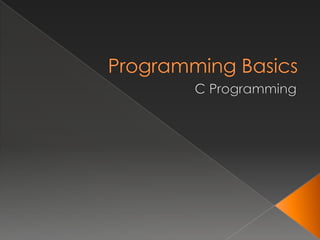
Programming basics
- 2. Before I explain any int main() { code to you, I int i; would like you to int sum = 0; execute your first for(i = 0; i<10; i++){ sum += i; program by } copying and printf("Sum = %dn", sum); pasting my code. //system("pause"); return 0; }
- 3. Locate the compile button and run buttons in your program. You may alternatively find the compile and run button that executes both at once. You should notice a black box appearing and disappearing very quickly. That is because I have allowed this code to execute without any pause statements.
- 4. Programs typically automatically close once the final line of code is reached. The line system(“pause”); needs to be added to “pause” the program in place The system pause should be placed right before the return 0; line of any program. Return 0 is typically used at the end of a program to tell the computer the program has ended.
- 5. Code is normally presented omitting the system("pause"); statement which confuses new programmers. Always make a mental note to add it in if you are testing new code.
- 6. When you place // before a line of code, you comment the code out and cause the compiler to skip over the code. Now you can remove the // before the system pause line in the example program and run the program again to see output. If all is correct, you should see the output being Sum = 45.
- 8. I want to draw your attention to the first line: int main(){ This is the beginning of your main function. The function ends with the use of }. Any time you open a { bracket, you must close it with a } bracket. As you can see with the main function, you can see the entire main function enclosed within the { } brackets. Additional code is allowed within the brackets. This includes code that uses another set of { } as well. The last { bracket to be opened is the first one to be closed when a } bracket is used.
- 9. The main function is the starting point of a program and where a compiler first starts to execute your code. It is required in order to compile your code, therefore it would be a good practice to use the following template.
- 10. int main(){ //your new written code goes here system("pause"); return 0; }
- 11. Our program is going to need a way to hold our values These values are stored in different types of variables. Integers, floats, and doubles are the main “number” holders of a program. A variable in C programming must always be declared at the top of the program right under int main() { if you want to use the variable in your program. Unlike some programming languages, you may not locally declare a variable anywhere.
- 12. An integer is a number only representable in a whole number form. Integers: 1,2,3,4,5.. Not Integers: 1.5, 1.7, 2.5, 3.9, 1003.4... Integer math is the calculation between two integers. The math is calculated as you would normally between any two numbers except the decimal value is dropped. Ex. 1+3=4, 1+.5=1 , 5/4 = 1
- 13. Double and Float variables allow the use of decimal numbers. A float has a smaller default precision than a double. If you declare a float and then try to store the number within the float into a double, you may be transferring only part of the number. A float allows at most about 7 decimal places precision. A double allows at least 7 places. To accurately work beyond 7 decimals you may require addition resources.
- 14. I typically use only Doubles when working with decimals and will work with only Doubles within these tutorials. The math calculated with a double or float does not use integer math. It would be safe to assume the calculated answer would be similar to the answer given in a math class.
- 15. An integer is declared by typing int variablename; A float is declared by typing float variablename; A double is declared by typing double variablename; The variablename is changeable to anything starting with a letter and anything that has not been assigned to a variable yet.
- 16. Multiple variables of the same type are declarable by adding a comma after the first variable and then typing the second. int one, two, three;
- 17. The point of a variable is to eventually hold data. The variable could be initialized immediately with a value. int one = 1; double duck = 12.5;
- 18. To print out the value a variable is holding you use the printf statement printf(“The variable one = %d”, one); As shown above, the text you want printed out is held within the quotation marks. A %variabletype is added to signal to the computer you want to print out a variable. int -> %d float -> %fl double -> %lf After the comma, you list the variables in order that match up with the %variables
- 19. A double could be printed out but it may contain too many decimal places. Limit a double by using %.#lf for the number of decimal places you want to be printed out. The key “n” to a computer is interpreted as a line break. When used in a printf statement, it will add a line break into the output.
- 20. int main(){ int one = 5.5; float two = 7.5; double three = 10.5; printf("One equals: %d n", one); printf("Two equals: %f n", two); printf("Three equals: %lf n ", three); three = 15; printf("Three equals: %lf ", three); system("pause"); return 0; }
- 21. Programming Template Integers, Floats, and Doubles Printf statements